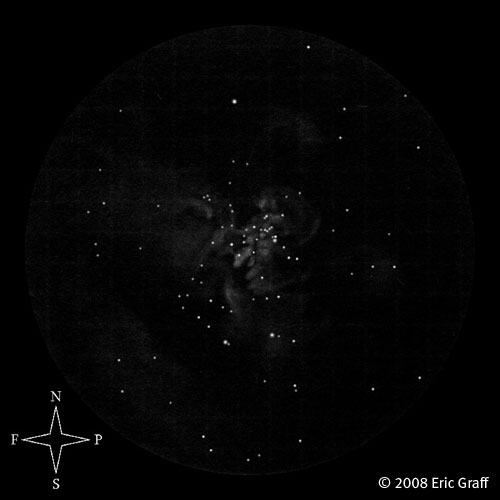
Click image for larger version.

Click image for larger version.
Object Name: Messier 16
Also Known As: NGC 6611, Cr 375, Mel 198, C1816-120, IC 4703, Sh2-49, Eagle Nebula, Star Queen Nebula
Object Type: Open Cluster + Emission Nebula + Dark Nebula
Constellation: Serpens (Cauda)
Right Ascension (2000.0): 18h 18m 45.0s
Declination (2000.0): –13° 47' 54"
Magnitude: 6.0
Size: Cluster 21'; Nebula 35' x 28'
NGC Description: Cl, at least 100 st L & S
Discovery: Philippe Loys de Chéseaux, 1746
Date/Time: 4 July 2008 • 04:20 to 06:45 UT
Location: Oakzanita Springs (4,010 ft. elevation), San Diego Co., California, USA
Telescope: Parks Astrolight EQ6 • 6" f/6 Newtonian Reflector
Eyepiece/Magnification: Parks 15mm Gold Series Plössl • 60x • 52' FoV
Filters: Lumicon OIII
Conditions: Clear, calm, 62°F
Seeing: Pickering 4-5
Transparency: NELM 6.3; TLM 14.0
The Eagle Nebula (or the Star Queen Nebula, if you prefer) is one of the most spectacular "Great Nebulae" in the sky – in photographs, anyway. Unlike other emission nebulae on Messier's list (M8, M17, M20, and M42-43), the Star Queen does not willingly yield her secrets to the visual observer. In fact, she puts up a rather tenacious fight.
The sky was not quite wholly dark when I centered my scope on M16 soaring above the brink of Oakzanita Peak. The nebulosity itself was not visible yet, but I immediately set to work sketching the visible members of the bright and easy open cluster invested in the nebula. By the time this task was completed the sky had darkened completely as the billowing clouds and star-studded reaches of the Milky Way cast their net above the entire eastern horizon. In the eyepiece gossamer veils of tenuous nebulosity draped lazily over the sparkling star cluster like a lumpy, disheveled cloak.
The best view in my scope occurs at 60x magnification with an OIII filter. The nebulosity is complex and the hazy morass dancing with subtle possibilities, but getting that detail onto paper was challenging; the region around the famous "Pillars of Creation" was particularly difficult in this regard. Once I was satisfied that I had done all I could with the central portion of the nebula I was able to pick up faint, nearly featureless extensions on nearly every side by placing the cluster just outside the field of view and sweeping slowly from side to side (N-S or E-W; kind of like looking for the tail of a comet).
Sketch and report provided with permission, courtesy of Eric Graff.